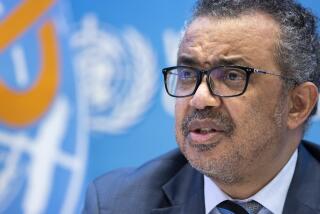New HIV infections in decline
- Share via
The estimated number of new HIV infections each year has declined about 17% since 2001, but for every five people infected, only two begin treatment, according to a report from the World Health Organization and UNAIDS released Tuesday.
About 2.7 million people were newly infected with the virus that causes AIDS last year, compared with about 3.3 million in 2001 -- although direct comparisons are difficult because the numbers are counted differently now. The biggest gains were in sub-Saharan Africa, where there were 400,000 fewer infections, even though the region still accounts for 67% of all new infections.
An estimated 33.4 million people were HIV-positive worldwide in 2008, a slight increase from 33 million in 2007. That increase occurred in large part because more people are living longer after infection because of the increased availability of antiretroviral drugs that keep the virus in check.
About 4 million people were receiving AIDS drugs at the end of 2008, compared with 3 million the previous year. Nonetheless, an additional “5 million people need treatment and are not receiving it,” Dr. Teguest Guerma, acting director of the WHO’s HIV/AIDS department, said at a Tuesday news conference.
She said that about 2.9 million lives had been saved so far by increased access to the drugs as a result of the U.S. President’s Emergency Plan for AIDS Relief and other international assistance programs.
The drugs have also cut down on mother-to-child transmission and reduced the number of orphaned children. About 200,000 infant infections have been averted since 2001, Guerma said.
Even so, about 430,000 children were born with HIV in 2008, bringing the number of children under the age of 15 living with the virus to 2.1 million.
The report was formally released in Shanghai by UNAIDS Executive Director Michel Sidibe because of concerns that China will become a new epicenter of the AIDS pandemic. HIV infections were once a problem only with homosexuals and intravenous drug abusers in that country, but the pandemic is rapidly spreading into the general population.
The rate of new infections through heterosexual contact in China tripled between 2005 and 2007, according to the new report. About 40% of new infections were acquired through heterosexual contact last year, with homosexual sex accounting for 32% and most of the rest related to drug abuse.
According to the Chinese government, the number of people confirmed to be living with HIV was 319,877 at the end of last month, up from 135,630 in 2005. Most experts view those numbers as suspiciously low, however, for the world’s most populous country. In large part, that is because the groups most at risk are highly stigmatized in China and at risk of imprisonment or harsher penalties, so it is difficult to get accurate numbers.
A similar situation occurs in the Middle East and North Africa, according to Dr. Paul De Lay, a deputy executive director of UNAIDS. “Even in sub-Saharan Africa, we still have a dearth of information about high-risk groups,” he said.
As in China, the AIDS epidemic is changing in Eastern Europe and Central Asia. Where it once was characterized chiefly by drug abuse and prostitution, it is now spreading into the general population. AIDS prevention programs in those regions are not shifting as rapidly, and are still focused on high-risk groups.
More to Read
Sign up for Essential California
The most important California stories and recommendations in your inbox every morning.
You may occasionally receive promotional content from the Los Angeles Times.












